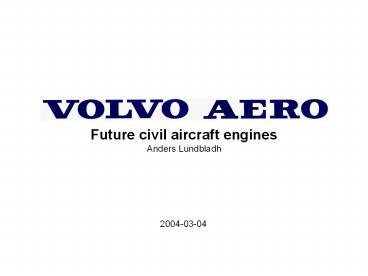Future%20civil%20aircraft%20engines%20Anders%20Lundbladh - PowerPoint PPT Presentation
Title:
Future%20civil%20aircraft%20engines%20Anders%20Lundbladh
Description:
Two lobe body gives more design freedom for passanger and freight space ... 6500m from brake release. 450 m off centre line. Volvo Aero Engines, Anders Lundbladh ... – PowerPoint PPT presentation
Number of Views:135
Avg rating:3.0/5.0
Title: Future%20civil%20aircraft%20engines%20Anders%20Lundbladh
1
Future civil aircraft enginesAnders Lundbladh
2
Boeing superefficient airplane 7E7
Two lobe body gives more design freedom for
passanger and freight space
A-A
7/8 seats wide
Raked wingtip from 777-300ER and 767-400ER
Long pods for engines with mixed flow
? BPR10 Nozzle from CF34-10
A
A
A
A
Long slender wings
Composite technology form the Sonic Cruiser
Tail wedge from MD-11
3
Range and passanger
A330 (also with new engines) shorter range than
7E7
777-200LR not built yet
7E7-domestic close to 757 A300/310
7E7 gives 777-range for 200-pass. class
7E7s long range leaves a regions around present
767
New engine
4
Engine Technology
RR TRENT 900
- Basically builds on TRENT900/GP7000/GE90
- Small improvements possible on compressor and
turbine - Higher BPR ca 10, OPR 45-50
- Slowly moving fans
- Much emphasis on low weight, aluminum
- More Electric Aircraft
- SFC approx 14.5 mg/Ns at cruise M0.85
- Ca 8 better than CF6-80 on B767/A330
- Ca 2 better than TRENT900/GP7000/GE90-115
VAC ICC
5
Fuel consumption
7E7-baseline comsumes approx. 10-15 less than
767-300ER 9 less than A330-200
7E7-stretch comsumes approx. 14 less than
A330-200 and 9 less than777-300ER
domestic as 757 15-20 better than
A300/310
6
How efficient is an engine ?
- SFC vflight /( FHV ?tot )
- ?tot ?core ?transfer ?propulsive
- ?thermal
7
Engine type and exhaust velocity
Rolls-Royce Turbofan BPR 7-8 vut 400 m/s
GE UnDucted Fan BPR ? 25 vut280 m/s
MTU Geared Fan BPR 14 vut340 m/s
8
Specific fuel consumption
SFC mg/Ns
Turbofan BPR 7
Shock losses from fan blades
Geared Fan BPR 14
Typical Cruise Speed M0.78-0.85
Unducted Fan BPR 25
9
Aircraft/Engine-parameters Affecting
Certification Noise Data
Sideline Depends mainly on the emitted sound
energy from the jet. The dominant factor is the
total installed thrust and to some extent the jet
specific thrust (jet velocity - although the
variation from engine to engine is quite small)
Takeoff Depends mainly on the speed of climb
which sets the distance to the measuring station
1/d2 and the power of the noise source (see
sideline). The rate of climb is set by the excess
thrust/weight
Approach Correlates mainly with drag and thrust
needed during approach
Sideline
450 m off centre line
Takeoff
Approach
6500m from brake release
2500 m from runway start
Heathrow noise classification based on mean of
sideline and takeoff Night landing restrictions
from 2002 95.9 EPNdBA
2-engine aircraft has more installed thrust than
4-engine aircraft
10
Driving Forces in Airline Engine
DesignStakeholder Needs and Wants
- Travelers
- safety, cost of travel, speed, cabin noise and
air quality - Airlines
- safety, cost, fuel consumption, maintenance
(cost) - Aircraft integrators
- airframe compatibility, thrust, size weight
- Airport neighbors
- safety, exterior noise
- Authorities, public
- safety, environmentally impacting emissions
11
Fuel Efficiency Trends Factors
- Since the fifties the fuel consumption of
jetliners has been decreased by more than 50 - stemming from more efficient aircraft
- Better aerodynamics
- More efficient packing
- New lighter materials and improved construction
- more efficient engines
- Better materials cooled turbines allowing
higher temperatures. - Optimizing for higher temps ? higher pressures.
- Arrival and optimization of the bypass turbofan.
- but configuration changes have been few ?
component technology has been pressed close to
the limit.
12
New Engine ConfigurationsAdvantages
- Geared fans
- Potentially lower weight
- Unducted fans (propfans)
- Higher propulsive efficiency
- Heat exchanged cycles
- Higher thermal efficiency through
- recovery of unused thermal exhaust energy
- decrease of compression work
- Constant volume combustion
- Higher thermal efficiency
13
Engine Cycle Selection
- Aim for low operating cost
- Preliminary studies may aim to minimize
- enginefuel weight
- take off weight
- Engine cycle must be translated into fuel burn,
engine weight, installation weight and drag - Engine layout may be used to compute engine weight
14
The Positive Carousel Effect
Lower drag
Smaller,lighter, aircraft
Lower thrust
Less mission fuel
Smaller engines
Higher specific power
Higher engine efficiency































